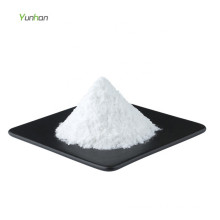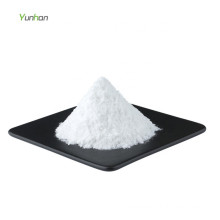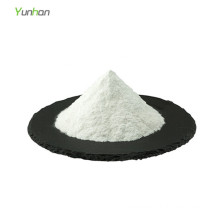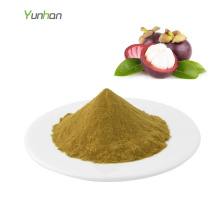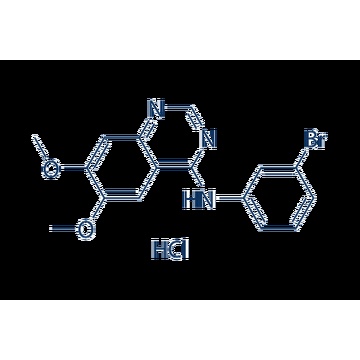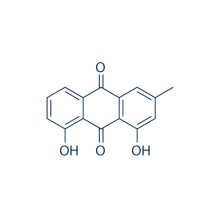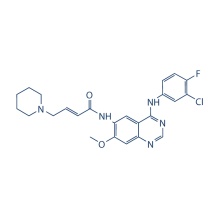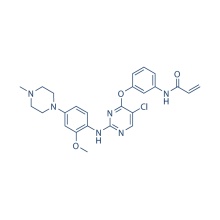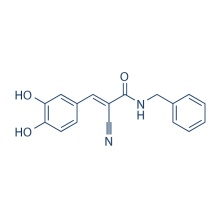PD153035 HCl 183322-45-4
Product Description
.cp_wz table {border-top: 1px solid #ccc;border-left:1px solid #ccc; } .cp_wz table td{border-right: 1px solid #ccc; border-bottom: 1px solid #ccc; padding: 5px 0px 0px 5px;} .cp_wz table th {border-right: 1px solid #ccc;border-bottom: 1px solid #ccc; padding: 5px 0px 0px 5px;}
Molecular Weight:
396.67 PD153035 is a potent and specific inhibitor of EGFR with Ki and IC50 of 5.2 pM and 29 pM; little effect noted against PGDFR, FGFR, CSF-1, InsR and Src.
Biological Activity
PD 153035 shows a potent and selective inhibitory effect on tyrosine
phosphorylation induced with EGF with IC50 of 15 nM and 14 nM in Swiss
3T3 fibroblast and A-431 human epidermoid carcinoma cells, respectively. PD153035 shows growth inhibitory effects in cultures of
EGF receptor-overexpressing human cancer cell lines including A431,
Difi, DU145, MDA-MB-468 and ME180 cells with IC50 of 0.22 μM, 0.3μM, 0.4
μM, 0.68 μM and 0.95 μM, respectively.
PD153035 induces a
dose-dependent growth inhibition in nasopharyngeal carcinoma (NPC)
cells including NPC-TW01, NPC-TW04, and HONE1 cell lines with IC50 of
12.9 μM, 9.8 μM and 18.6μM, respectively. A recent study
shows that PD153035 abolishes COX-2 expression induced by the
PAR(2)-activating peptide 2-furoyl-LIGRLO-NH(2) (2fLI) in Caco-2 colon
cancer cells.
In A431 human epidermoid tumors grown as xenografts in immunodeficient
nude mice, PD153035 at 80 mg/kg inhibit EGF receptor tyrosine kinase
activity. PD153035 improves glucose tolerance, insulin sensitivity, and signaling and reduces subclinical inflammation in HFD-fed mice. Pretreatment of EGFR Inhibitors by 24 hours significantly enhances the
cytotoxic effect of doxorubicin, paclitaxel, cisplatin, and
5-fluororuacil in NPCTW04 cells.
Protocol(Only for Reference)
Kinase Assay: [1]
Cell Assay: [2]
Animal Study: [5]
Conversion of different model animals based on BSA (Value based on data from FDA Draft Guidelines)
For example, to modify the dose of resveratrol used for a mouse (22.4 mg/kg) to a dose based on the BSA for a rat, multiply 22.4 mg/kg by the Km factor for a mouse and then divide by the Km factor for a rat. This calculation results in a rat equivalent dose for resveratrol of 11.2 mg/kg.
Chemical Information
Molarity Calculator
Dilution Calculator
Molecular Weight Calculator
Contact us if you need more details on 183322-45-4. We are ready to answer your questions on packaging, logistics, certification or any other aspects about PD153035 HCl 183322-45-4、183322-45-4 PD153035 HCl. If these products fail to match your need, please contact us and we would like to provide relevant information.
Molecular Weight:
396.67 PD153035 is a potent and specific inhibitor of EGFR with Ki and IC50 of 5.2 pM and 29 pM; little effect noted against PGDFR, FGFR, CSF-1, InsR and Src.
Biological Activity
PD 153035 shows a potent and selective inhibitory effect on tyrosine
phosphorylation induced with EGF with IC50 of 15 nM and 14 nM in Swiss
3T3 fibroblast and A-431 human epidermoid carcinoma cells, respectively. PD153035 shows growth inhibitory effects in cultures of
EGF receptor-overexpressing human cancer cell lines including A431,
Difi, DU145, MDA-MB-468 and ME180 cells with IC50 of 0.22 μM, 0.3μM, 0.4
μM, 0.68 μM and 0.95 μM, respectively.
PD153035 induces a
dose-dependent growth inhibition in nasopharyngeal carcinoma (NPC)
cells including NPC-TW01, NPC-TW04, and HONE1 cell lines with IC50 of
12.9 μM, 9.8 μM and 18.6μM, respectively. A recent study
shows that PD153035 abolishes COX-2 expression induced by the
PAR(2)-activating peptide 2-furoyl-LIGRLO-NH(2) (2fLI) in Caco-2 colon
cancer cells.
In A431 human epidermoid tumors grown as xenografts in immunodeficient
nude mice, PD153035 at 80 mg/kg inhibit EGF receptor tyrosine kinase
activity. PD153035 improves glucose tolerance, insulin sensitivity, and signaling and reduces subclinical inflammation in HFD-fed mice. Pretreatment of EGFR Inhibitors by 24 hours significantly enhances the
cytotoxic effect of doxorubicin, paclitaxel, cisplatin, and
5-fluororuacil in NPCTW04 cells.
Protocol(Only for Reference)
Kinase Assay: [1]
| Inhibition of EGF receptor tyrosine kinase | Enzyme reactions are performed in a total volume of 0.1 mL containing 25 mM Hepes (pH 7.4), 5 mM MgCl2, 2 mM MnCl2, 50 μM sodium vanadate, 0.5 to 1.0 ng of enzyme (which also contains enough EGF to make the final concentrations 2 μg/mL), 10 μM ATP containing 1 μCi of [32P]ATP, varying concentrations of PD153035, and 200 μM of a substrate peptide based on a portion of phospholipase C-γl having the sequence Lys-His-Lys-Lys-Leu-Ala-Glu-Gly-Ser-Ala-Tyr472-Glu-Glu-Val. The reaction is initiated by the addition of ATP. After 10 minutes at room temperature, the reaction is terminated by addition of 2 mL of 75 mM phosphoric acid, and the solution is passed through a 2.5-cm phosphocellulose filter disk that binds the peptide. The filter is washed five times with 75 mM phosphoric acid and placed in a vial with 5 mL of scintillation fluid. The uninhibited control activity produces approximately 100,000 cpm. |
|---|
Cell Assay: [2]
| Cell lines | A431, Difi, DU145, MDA-MB-468 and ME180 |
|---|---|
| Concentrations | 0-3 μM |
| Incubation Time | 72 hours |
| Method | Cells are seeded in sixwell plates. The next day, cells are changed to medium containing 0.5% FBS for 18 hours, and then PD153035 is added at various concentrations to the cultures. After 72 hours of treatment, cells are washed once with PBS, harvested with 0.1% human trypsin-l mM EDTA in PBS, and counted with a Coulter counter. The CMK cells grow in suspension and, therefore, do not require trypsinization. |
Animal Study: [5]
| Animal Models | A431 cells are injected into the outbred nude mice. | ||
|---|---|---|---|
| Formulation | PD153035 is dissolved in water. | ||
| Dosages | ≤80 mg/kg | ||
| Administration | Administered via i.p. | ||
| Solubility | 30% propylene glycol, 5% Tween 80, 65% D5W, 30 mg/mL | ||
| * Please note that Selleck tests the solubility of all compounds in-house, and the actual solubility may differ slightly from published values. This is normal and is due to slight batch-to-batch variations. | |||
Conversion of different model animals based on BSA (Value based on data from FDA Draft Guidelines)
| Species | Baboon | Dog | Monkey | Rabbit | Guinea pig | Rat | Hamster | Mouse |
| Weight (kg) | 12 | 10 | 3 | 1.8 | 0.4 | 0.15 | 0.08 | 0.02 |
| Body Surface Area (m2) | 0.6 | 0.5 | 0.24 | 0.15 | 0.05 | 0.025 | 0.02 | 0.007 |
| Km factor | 20 | 20 | 12 | 12 | 8 | 6 | 5 | 3 |
| Animal A (mg/kg) = Animal B (mg/kg) multiplied by | Animal B Km |
| Animal A Km |
For example, to modify the dose of resveratrol used for a mouse (22.4 mg/kg) to a dose based on the BSA for a rat, multiply 22.4 mg/kg by the Km factor for a mouse and then divide by the Km factor for a rat. This calculation results in a rat equivalent dose for resveratrol of 11.2 mg/kg.
| Rat dose (mg/kg) = mouse dose (22.4 mg/kg) × | mouse Km(3) | = 11.2 mg/kg |
| rat Km(6) |
Chemical Information
| Molecular Weight (MW) | 396.67 |
|---|---|
| Formula | C16H14BrN3O2.HCl |
| CAS No. | 183322-45-4 |
| Storage | 3 years -20℃Powder |
|---|---|
| 6 months-80℃in solvent (DMSO, water, etc.) | |
| Synonyms | SU-5271 (AG1517) HCl ,ZM 252868 HCl |
| Solubility (25°C) * | In vitro | DMSO | 0.5 mg/mL (1.26 mM) |
|---|---|---|---|
| Water | <1 mg/mL ( | ||
| Ethanol | <1 mg/mL ( | ||
| In vivo | 30% propylene glycol, 5% Tween 80, 65% D5W | 30 mg/mL | |
| * <1 mg/ml means slightly soluble or insoluble. * Please note that Selleck tests the solubility of all compounds in-house, and the actual solubility may differ slightly from published values. This is normal and is due to slight batch-to-batch variations. | |||
| Chemical Name | N-(3-bromophenyl)-6,7-dimethoxyquinazolin-4-amine hydrochloride |
|---|
Molarity Calculator
Dilution Calculator
Molecular Weight Calculator
Contact us if you need more details on 183322-45-4. We are ready to answer your questions on packaging, logistics, certification or any other aspects about PD153035 HCl 183322-45-4、183322-45-4 PD153035 HCl. If these products fail to match your need, please contact us and we would like to provide relevant information.
Product Categories : Protein Tyrosine Kinase > EGFR Inhibitor
Other Products
Hot Products
Astragaloside AChlortetracycline HCl 64-72-2Paclitaxel 33069-62-4Dexamethasone Acetate 1177-87-3Dinaciclib (SCH727965) 779353-01-4CHIR-124 405168-58-3Ro3280 1062243-51-9TAME 901-47-3CCG-1423 285986-88-110058-F4 403811-55-2Dabigatran (BIBR 953) 211914-51-1H 89 2HCl 130964-39-5T0901317 293754-55-9Aprepitant 170729-80-3Turofexorate Isopropyl (XL335) 629664-81-9BMS-378806 357263-13-9


